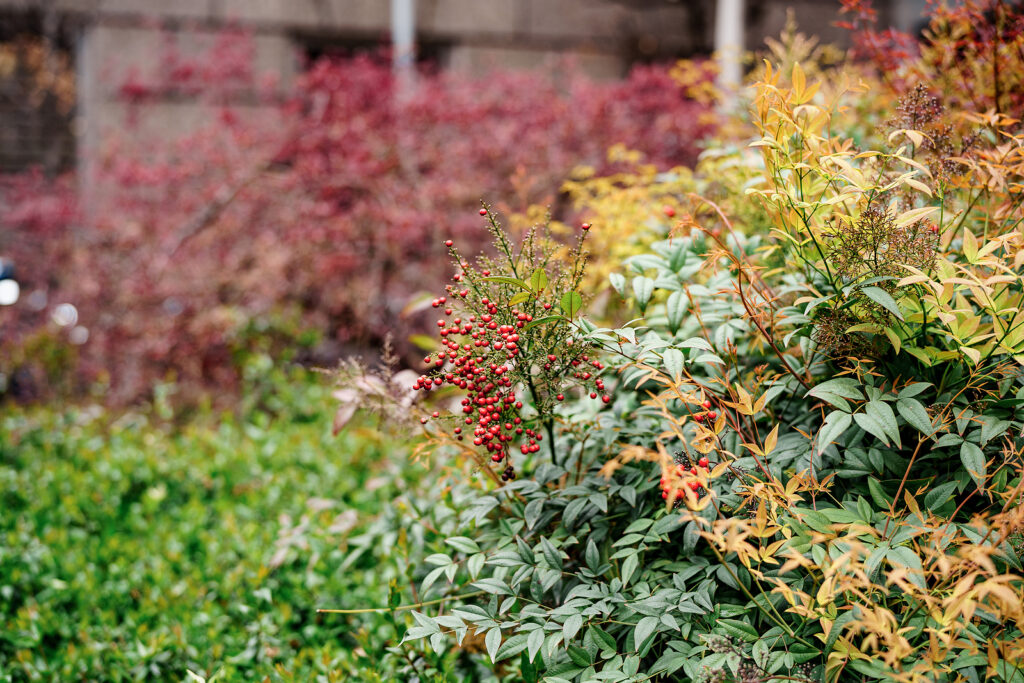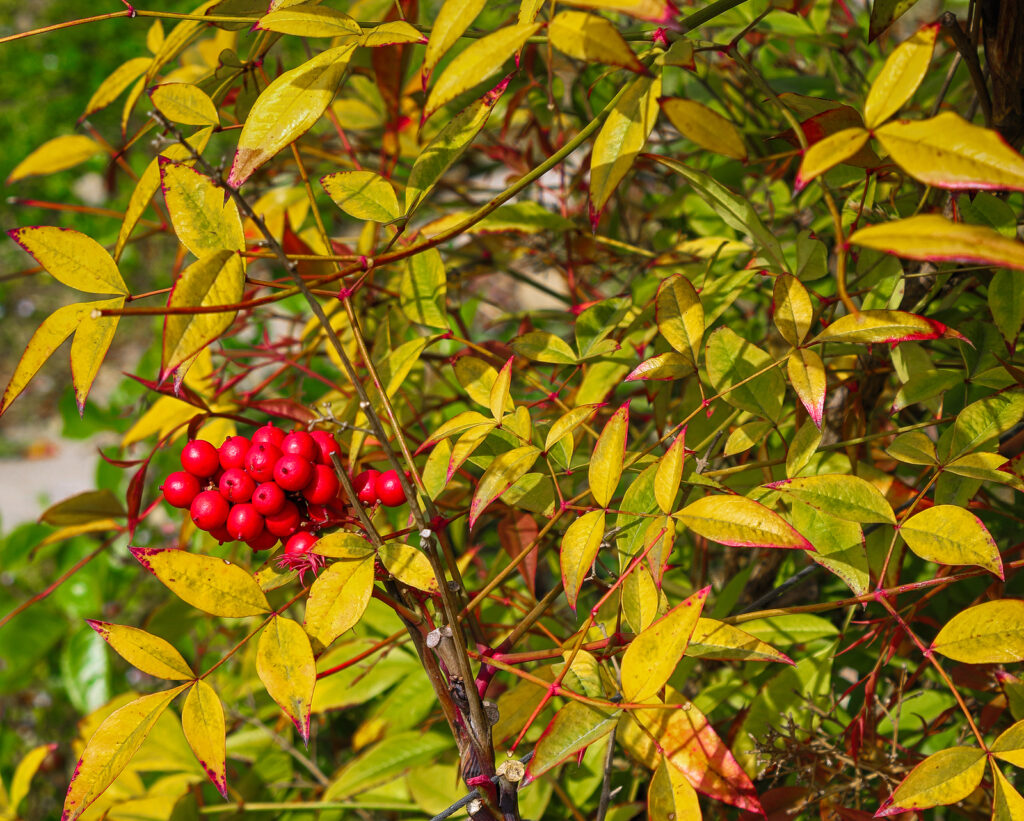Nandina — commonly called heavenly bamboo–is an evergreen shrub grown widely for its graceful habit and foliage–often bronze-red when young and again in fall. Nandina bears small white flowers in clusters and red berries that persist through winter.
Nandina is a slow to moderate grower and is most useful for its light, airy vertical effects as well as for its narrow growth habit. It is good as a hedge, screen, or tub plant. Nandina needs afternoon shade in the hottest climates. It can complete with tree roots in dry shade.
The Nanadina genus contains a single species, but there are several cultivars and almost all are available at nurseries. Nandina is native to mountain valleys in India, China, and Japan.

Get to know Nandina
- Plant type: Evergreen or semi-evergreen shrub.
- Growing zones and range: Zones 6 to 10.
- Hardiness: Hardy to Zone 6; stems are damaged at 5℉ /-15℃
- Height and width: 6-8 feet (1.8-2.4m) tall and 5 feet (1.5m) wide.
- Foliage: Slightly branched, canelike stems and delicate, handsome, glossy, compound leaves that are pink-bronze when unfurling, green in summer, and red-tinged in winter. Leaves are intricately divided into many 1-2 inches (2.5-5cm), pointed, oval leaflets, creating a lacy pattern.
- Flowers: Small white flowers form in loose, erect, 6-12 inches (15-31cm) clusters and if grouped, are followed by bright red fruits that last well into winter; however, single plants seldom fruit heavily.
- Bloom time: Midsummer.
- Uses: Shrub border, and in masses with heavier-foliaged plants; good for hedge, screen, tub effects as well as for narrow, restricted areas, and to provide winter interest. Dramatic with night lighting.
- Garden companions: golden privet (Ligustrum ovalifolium ‘Aereum’)
- Common name: Heavenly bamboo, sacred bamboo
- Botanical name: Nandina
- Family name: Berberidaceae
- Origin: India, China, Japan
Where to plant Nandina
- Plant Nandina in a sheltered area in full sun.
- Nandina needs afternoon shade in the hottest climates.
- Plant Nandina in well-drained average to humus-rich soil.
- Nandina foliage can become chlorotic in alkaline soil.

When to plant Nandina
- Set container-grown Nandina in the garden in spring or autumn.
- Plant Nandina seed in spring.
Planting and spacing Nandina
- Space Nandina 5 feet (1.5m) apart.
- Sow seed 1/4 inch deep in evenly prepared soil.
How to water and feed Nandina
- Give Nandina moderate water, but its roots can compete with tree roots in dry shade.
- Fertilize Nandina with an all-purpose organic fertilizer in spring.
How to care for Nandina
- Nandina can be pruned to the ground.
- Pruning old Nandina canes yearly will keep growth dense rather than leggy.
Nandina pests and diseases
- Nandina can develop wilt, leaf spot, rot, and viruses.
- Nandina have few pest problems.

Nandina propagation
- Divide Nandina clumps in spring.
- Root Nandina semi-hard cuttings in midsummer.
Nandina varieties to grow
- Nandina domestica, heavenly bamboo: unbranched stems to 6 feet (1.8m) tall form clumps similar to bamboo, with leaves divided into slender leaflets. The late-spring or early-summer flowers are white and borne in foot-long panicles. But they are outdone by the heavy clusters of red berries that last from early autumn through winter, often against bronze-purple or red foliage
- N. d. leucocarpa, ‘Alba’, standard size plant with creamy white berries and yellowish-green foliage that turns yellow in fall. More subject to cold damage than the species.
- ‘Compacta’. Lower growing than species—4-5 feet (1.2-1.5m)—with narrower, more numerous leaflets; has a very lacy look.
- ‘Firepower’. Compact plant to 2 feet (.6m) tall and wide. Red-tinged summer foliage turns bright red in winter.
- ‘Gulf Stream’ mounded form to 3 feet (.9m), red leaves in winter.
- ‘Harbour Dwarf’. Low growing, sucking form to 3 feet (.9m) tall, freely spreading, graceful, with smaller flower clusters. Underground rhizomes send up stems several inches from the parent plant. Orange-red to bronzy red winter color. Good ground cover.
- ‘Plum Passion’ is purple-red in winter; evergreen. 4-5 feet (1.6-2m) tall.
- ‘San Gabriel’ Under 2 feet (.6m) tall with narrow leaflets, less cold hardy.
- ‘Umpqua Warrior’ erect, 4-6 feet (1.2-1.8m) tall
- ‘Wood’s Dwarf’, very compact, red foliage, has excellent winter color. 18 inches (45cm) tall. Often killed to the ground or winter burned in Zone 6. 0















